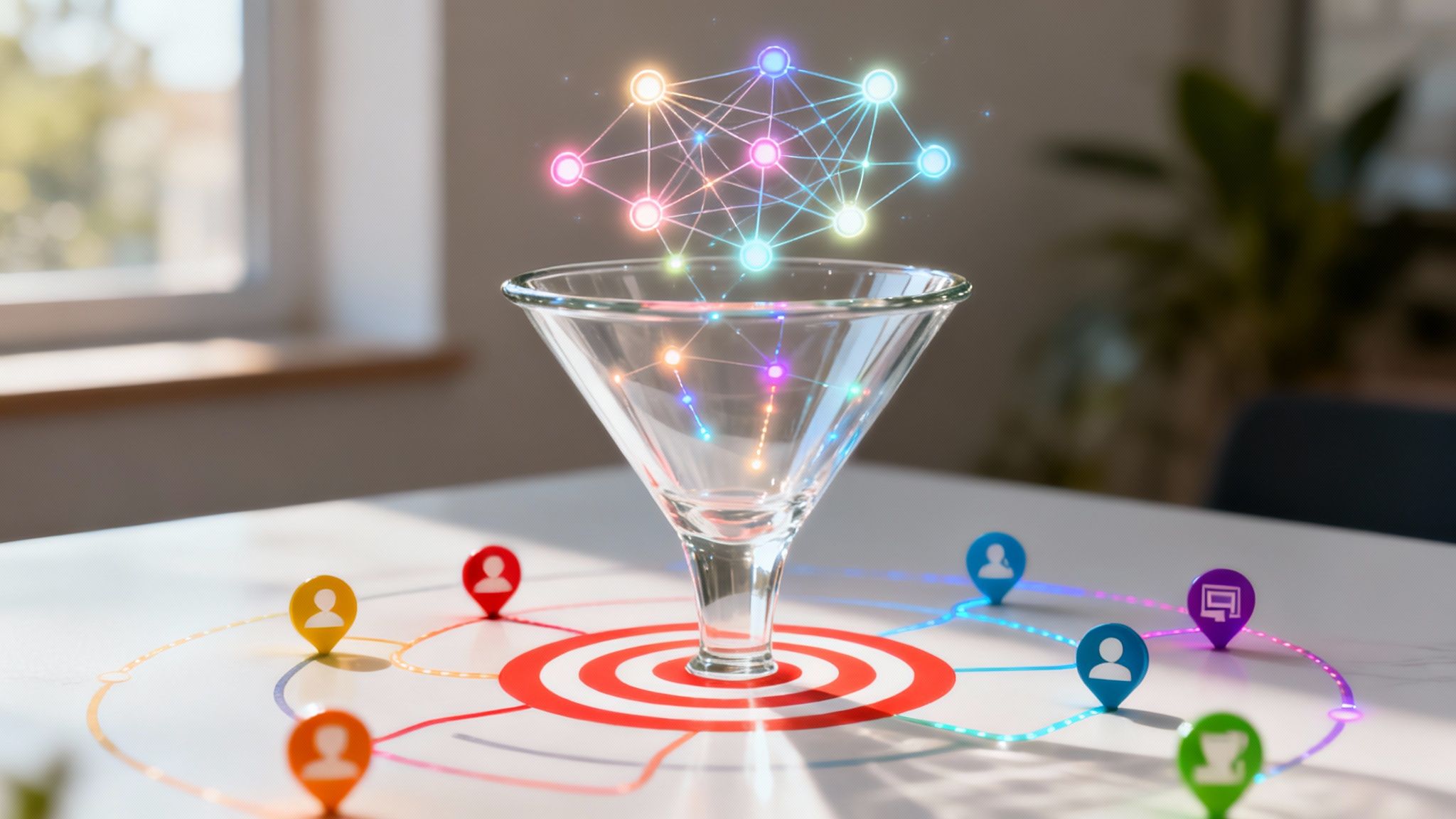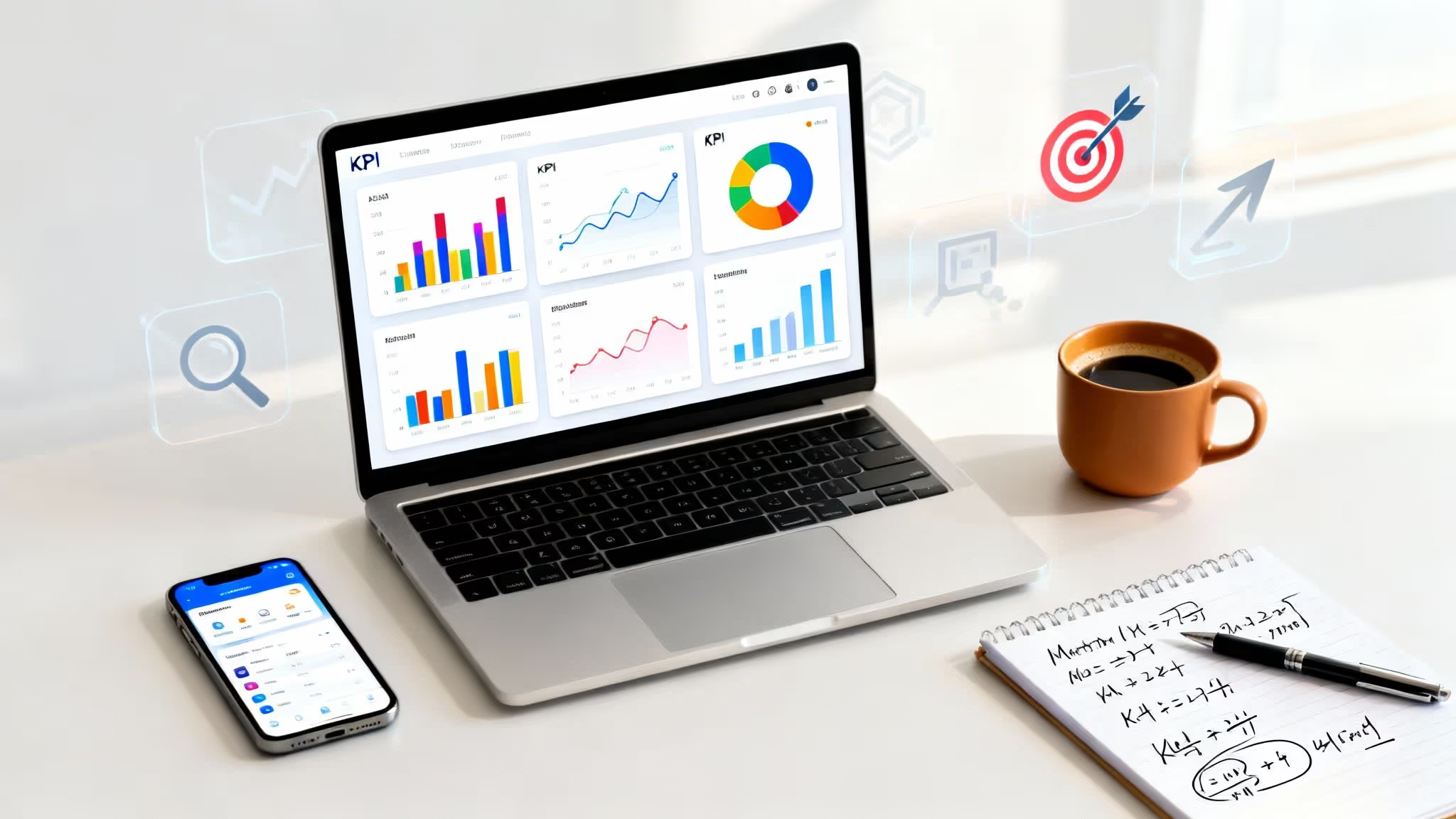Lead nurturing automation is the practice of using software to build and sustain relationships with potential customers. It operates by sending personalized, timely, and relevant content automatically. Instead of a salesperson manually tracking follow-ups, this technology intelligently guides leads through your sales funnel, ensuring no opportunity is missed.
What is Lead Nurturing Automation?

Imagine your leads are seedlings in a garden. Each has unique needs—some require more water, others more sun, and they all mature at different rates. Attempting to tend to each one by hand is not just inefficient; it's a guaranteed way to neglect potential growth.
This is where lead nurturing automation comes in. It acts as your expert gardener, working 24/7 to provide each lead with exactly what it needs to thrive. It moves beyond simple email blasts to create a unique journey for every prospect based on their behavior, interests, and demonstrated needs.
From Leaky Bucket to Conversion Engine
Without automation, a sales funnel often feels like a leaky bucket. Leads are poured in at the top, but far too many trickle out through gaps—missed follow-ups, generic messaging, or simple inattention. This is a frustratingly common problem, but one that is entirely fixable.
The fundamental purpose of lead nurturing automation is to plug those leaks. It ensures you're delivering:
- The Right Message: Content that speaks directly to a lead’s specific pain points and stage in the buying journey.
- The Right Time: Communication triggered by their actions, such as visiting your pricing page or downloading an ebook.
- The Right Channel: Reaching prospects where they are most active, whether that’s email, social media, or SMS.
When executed correctly, this transforms your leaky funnel into a powerful, self-sustaining conversion engine.
Building Relationships at Scale
At its core, lead nurturing is about building trust. It's about positioning your brand as a helpful authority long before a sales conversation begins. Automation allows you to cultivate thousands of these individual relationships simultaneously—a feat physically impossible for any human team to manage.
By systematically guiding prospects, you aren't just pushing for a sale; you're educating and empowering them to make a confident decision. This creates a stronger foundation for long-term customer loyalty.
The impact is significant. Companies that excel at lead nurturing generate 50% more sales-ready leads at a 33% lower cost. This efficiency stems from automated targeting, where personalized content and timely follow-ups naturally convert better. For instance, nurtured emails sent via automation can achieve 4 to 10 times higher response rates compared to generic email blasts.
By understanding this foundation, you can stop losing valuable leads and start building the kind of customer relationships that drive predictable growth. For a deeper look at how this all comes together in BB, explore our comprehensive guide on B2B marketing automation.
The Building Blocks of Your Nurturing Engine
An effective lead nurturing automation system isn’t a single piece of software; it's a high-performance engine with several critical components working in unison. Think of it like building a car: you need the engine, the right fuel, and a smart GPS to reach your destination—a new customer.
Each component serves a specific function, but their true power is unleashed when they connect to create a system that can guide prospects autonomously. Let's break down these essential parts.
Segmentation: The Foundation of Personalization
The first and most critical building block is segmentation. This is the practice of dividing your broad audience into smaller, more manageable groups based on shared characteristics. Without it, you’re delivering the same generic message to a diverse crowd and hoping it resonates with someone.
Segmentation allows you to move beyond generic communication and speak directly to a lead’s specific needs and context. You can group leads based on a variety of data points:
- Demographics: Their industry, company size, or job title.
- Behavior: Actions they've taken, like downloading a specific whitepaper, attending a webinar, or repeatedly visiting your pricing page.
- Engagement Level: How frequently they open your emails or click on your content.
By clustering similar leads, you lay the groundwork for sending relevant content that solves their specific problems. This is the first step in making your automation feel personal and helpful, not robotic.
Lead Scoring: The Prioritization System
Once your leads are segmented, you need a method for identifying who is genuinely interested and ready for a sales conversation. That’s the role of lead scoring. It’s a system for assigning points to leads based on their profile (firmographics) and their actions (engagement), creating a clear hierarchy of sales-readiness.
Think of it as a priority flag. A lead who downloads a detailed case study (a strong buying signal) might get +15 points, while someone who simply opens an email gets +2 points. If that lead is a C-level executive in a target industry, they might receive an additional +20 points based on their profile. When a lead's score reaches a predefined threshold, the system automatically designates them as a Marketing Qualified Lead (MQL) and notifies the sales team.
This data-driven approach ensures your sales team invests their time on the hottest prospects—those who have shown genuine interest and fit your ideal customer profile—dramatically boosting efficiency and conversion rates.
Properly implementing this is critical for aligning your sales and marketing teams. For a deeper dive into setting up a robust model, review these proven lead scoring best practices.
Workflows and Triggers: The Automated GPS
Finally, you need the "GPS" that directs the entire journey: workflows and triggers. A workflow is a pre-planned sequence of automated actions. A trigger is the specific event that initiates a workflow.
Here’s a practical example:
- Trigger: A user completes a form to download your ebook, "Project Management for Startups."
- Instantly: Send an email delivering the ebook.
- Wait 2 days: Send a follow-up email with a related blog post.
- Wait 4 days: Send a case study about how a similar startup used your product.
- If they click the case study: Add +10 points to their lead score and trigger an invitation to book a product demo.
- Analyze Email Replies: AI can interpret the sentiment and intent of an incoming email, then automatically route it to the right person or trigger the most appropriate automated response.
- Recommend the Next Best Action: By analyzing a lead’s complete history, AI tools can prompt a sales rep with the most effective next step—whether it's sending a specific case study or making a phone call.
- Customize Website Content: For a returning visitor, AI can dynamically alter headlines, CTAs, or images on your site to align with their industry and expressed interests.
- Goal Example: Increase the conversion rate of Marketing Qualified Leads (MQLs) to Sales Qualified Leads (SQLs) by 15% within the next quarter.
- Goal Example: Re-engage 10% of our dormant lead database, prompting them to download a new resource within 60 days.
- Awareness Stage: The prospect recognizes a problem (e.g., "Our project management is inefficient"). They are searching for educational content, not specific solutions.
- Consideration Stage: They are now actively researching solutions. They compare different software options, read reviews, and seek proof through case studies.
- Decision Stage: The prospect has narrowed their options to a shortlist. They are now ready for a demo, a price quote, or a free trial.
- For the Awareness Stage: Focus on educational, non-promotional content. Think blog posts, checklists, and guides that address their pain points.
- For the Consideration Stage: Provide more in-depth, solution-oriented content. This is the ideal time for webinars, detailed whitepapers, and compelling case studies that showcase your expertise.
- For the Decision Stage: Make it as easy as possible for them to choose you. Offer product demos, free trials, personalized consultations, and clear pricing information.
- Trigger: A lead submits the form for your "Ultimate Guide to Project Management."
- Action 1 (Immediate): Send an email delivering the guide.
- Wait 3 Days.
- Action 2: Send a relevant case study about a similar company's success.
- Wait 5 Days.
- Action 3: Send an invitation to a webinar on "Advanced Project Management Techniques."
- If lead registers for webinar: Add +15 points to their lead score and notify a sales rep.
- Email: The system immediately sends the ebook, followed by a related case study a few days later.
- Social Media: The same lead is added to a custom audience for a LinkedIn ad campaign promoting a webinar on the same topic.
- SMS: If they are a high-value lead who has opted in, they receive a text reminder one hour before the webinar begins.
- Calls-to-Action (CTAs): Does "Book a Demo" outperform "See It in Action"?
- Content Formats: Test plain-text emails against visually rich HTML templates.
- Message Timing: Do morning sends generate more clicks than afternoon sends for your audience?
- Sender Name: Compare a personal name (e.g., "John from Company") with the company name alone.
- Over-messaging: Bombarding leads with too many emails too quickly is a surefire way to drive them to unsubscribe.
- Generic Content: A one-size-fits-all approach is ineffective. If your messages don't address a lead's specific pain points, they will be ignored.
- Poor Data Quality: Inaccurate data leads to flawed segmentation, meaning you could be sending the right message to the wrong person, undermining your entire effort.
- Ignoring Other Channels: Relying solely on email is a missed opportunity. Overlooking touchpoints like SMS or social media retargeting limits your campaign's reach and impact.
This infographic illustrates how these components work together to deliver the right message, at the right time, through the right channel.

As the visual demonstrates, successful conversions aren't accidental. They are the result of a strategic, coordinated effort powered by these interconnected parts. By integrating segmentation, lead scoring, and automated workflows, you create a responsive system that nurtures each lead along their unique path to becoming a customer.
How AI Is Redefining Automated Nurturing

If traditional lead nurturing is a road trip following a pre-set map, then adding Artificial Intelligence is like giving that map a live traffic feed. It can now predict jams, find clever shortcuts, and adapt the route on the fly.
AI is transforming lead nurturing from a rule-based system into a predictive, adaptive engine. It elevates what was once a static sequence into a dynamic, intelligent conversation. This isn't just an upgrade; it's a fundamental shift. Where older systems were confined to rigid "if-this-then-that" logic, AI introduces a cognitive layer, empowering your nurturing workflows to make smarter decisions autonomously.
Moving Beyond Basic Lead Scoring
Traditional lead scoring is effective but retrospective, tallying points for past actions. AI introduces predictive lead scoring.
Instead of only counting what a lead has done, AI algorithms analyze vast datasets to identify the subtle patterns shared by your most successful customers. It then scans your current leads for those same digital fingerprints. The objective shifts from identifying who is engaged to answering a far more valuable question: who is most likely to convert, and what is the optimal moment to reach out?
This empowers your sales team to focus on leads with the highest statistical probability of closing, dramatically increasing efficiency and shortening the sales cycle.
Achieving Hyper-Personalization at Scale
Personalization has long been the goal of lead nurturing. AI makes hyper-personalization a scalable reality, even with thousands of leads. It can adjust messaging and content in real-time based on behavioral cues that a human would likely miss.
Imagine a system that can:
This level of one-to-one attention, delivered automatically, creates an experience where every prospect feels uniquely understood.
Intelligent Content Creation and Optimization
AI's influence extends beyond outreach; it's also revolutionizing the content that fuels your lead nurturing automation. It can analyze which blog posts, whitepapers, and case studies perform best at each stage of the buyer's journey. Armed with this data, AI tools can suggest new content ideas with a high probability of resonance or even help draft initial versions of emails and social media posts.
AI isn't just executing your nurturing strategy; it's actively helping you build and refine it. By identifying performance patterns, it helps marketers create more impactful content, ensuring the entire nurturing engine runs on high-octane fuel.
The impact of integrating AI is profound. Companies using AI-powered tools have reported up to a 451% increase in qualified leads. This massive jump is because AI automates repetitive tasks, tracks every interaction with precision, and delivers personalized outreach at a scale no human team can match.
By embracing these tools, you're not just making your nurturing efforts more efficient—you're making them vastly more intelligent. To explore specific platforms, check out our guide on the 12 best AI tools for digital marketing.
Building Your First Lead Nurturing Campaign
Translating theory into action is where real progress is made. Building your first automated nurturing campaign can feel intimidating, but by breaking it down into a logical, step-by-step process, it becomes not only manageable but empowering.
This roadmap will help you launch a sequence that engages new leads from the moment they connect with you. Think of it as creating a smart assistant for your sales team, one whose sole purpose is to educate and qualify new contacts so that when a salesperson steps in, the conversation is already warm.
Let's walk through the essential steps to get your first campaign live.
Step 1: Define Your Campaign Goals
Before writing a single email or configuring your automation software, you must define what success looks like. A campaign without a clear goal is simply a series of disconnected messages. Your objective should be specific, measurable, and directly tied to a business outcome.
Avoid vague goals like "nurture leads." Get specific.
Having a quantifiable target provides a clear benchmark for success. It tells you exactly what to measure and helps you demonstrate that your lead nurturing automation strategy is delivering tangible results.
Step 2: Map the Customer Journey
Next, step into your customer’s shoes. What path do they follow from identifying a problem to making a purchase decision? Mapping this journey is crucial because it allows you to align your content with their mindset at each stage.
A prospect who has just discovered your brand requires entirely different information than someone actively comparing you against competitors.
A simple journey map for a B2B software company might look like this:
Plotting these stages helps you deliver the right message at the right time, preventing you from pushing for a demo too early or sending introductory content to someone who is ready to buy.
Step 3: Create Stage-Specific Content
With your journey map complete, it’s time to create or repurpose content that aligns perfectly with each stage. Relevance is paramount. Your content must answer the specific questions your prospect has at that exact moment.
Your content isn't just a sales tool; it's a service. By providing genuinely helpful information that addresses their challenges, you build the trust required to earn their business.
Here’s a breakdown of how to match content to each stage:
Great content is the fuel for your nurturing engine. If you need help structuring the email component, our guide on how to build a winning email marketing campaign offers a solid foundation.
Step 4: Build Your Workflow and Set Triggers
Now it’s time to use your marketing automation software. A workflow is the sequence of actions your system will take automatically. It's the "if this happens, then do that" logic that animates your campaign.
Start by defining your entry trigger—the specific action a lead takes that initiates the journey. A classic example is a form submission for an ebook.
Example Workflow:
This structured flow ensures your communication is timely and valuable, guiding leads forward without manual intervention. You can start with a basic workflow like this and add complexity as you grow.
Advanced Strategies for High-Impact Workflows
Launching your first automated campaigns is a significant achievement. The real competitive advantage, however, comes from refining that system into a true growth engine. The difference between a good and a great nurturing strategy lies in the details of orchestrating an experience that feels personal, seamless, and perfectly timed.
Advanced lead nurturing automation moves beyond sending more emails. It’s about creating a unified conversation with prospects across every touchpoint. This means architecting the entire customer journey, not just a single channel, to accelerate revenue and build lasting relationships.
Orchestrate Multi-Channel Nurturing
Today's buyers interact with brands across numerous platforms, and your nurturing strategy must reflect that reality. An advanced approach coordinates touchpoints across multiple channels to create a consistent and reinforcing message.
Consider a lead who downloads an ebook. A multi-channel workflow could trigger the following:
This method keeps your brand top-of-mind without being intrusive. Each touchpoint builds on the last, creating a sense of omnipresence that fosters trust and authority. You can explore the mechanics further in our guide on designing effective marketing workflow automation.
Balance Automation with the Human Touch
As powerful as automation is, it should never fully replace human interaction, especially in high-value B2B sales. The most effective strategies blend automated efficiency with timely, personal outreach. The key is using automation to identify the precise moment for a human to intervene.
Use automation to handle repetitive, top-of-funnel communication, but trigger alerts for your sales team when a lead demonstrates strong buying intent. This frees up your team to focus on building relationships, not just sending follow-ups.
For example, if a lead with a high score visits your pricing page and then watches a product demo, the system should do more than send another automated email. It should trigger an immediate notification to the assigned sales rep with an activity summary, prompting a personal call or a highly customized email. This hybrid model ensures your most promising leads receive the attention they deserve.
Master Timing and Frequency
One of the quickest ways to lose a prospect is to overwhelm them. Too many messages too quickly can lead to fatigue and unsubscribes. Conversely, waiting too long between touchpoints allows them to go cold. Finding the perfect cadence is both an art and a science.
Use your platform's analytics to guide your decisions. Look for patterns: do your leads engage more on Tuesday mornings? Does engagement drop after the third email in a sequence? Let the data inform your strategy. A solid approach might involve an initial burst of communication post-signup, followed by a more deliberate pace of one valuable touchpoint per week.
Relentlessly A/B Test Everything
In the world of optimization, assumptions are the enemy of progress. The only way to truly know what resonates is to test it relentlessly. A/B testing should be a core, ongoing component of your advanced nurturing strategy.
Don't limit your tests to subject lines. Experiment with:
Even small, incremental improvements from A/B testing can compound over time, leading to significant lifts in engagement and conversion rates.
Frequently Asked Questions
As you delve into lead nurturing automation, questions are bound to arise. Whether you're just starting or looking to optimize an existing strategy, certain common challenges often appear. Here, we address those practical concerns with clear, actionable answers.
How Do I Know If My Business Is Ready for Automation?
The clearest indicator is your team's workload. Are they struggling with manual follow-ups? If your sales reps find it difficult to maintain consistent communication or spend too much time on leads who aren't ready to buy, it's a sign that automation can provide immediate value.
Another signal is a steady stream of inbound leads that fail to convert at an acceptable rate. If you are already creating content like blog posts, webinars, or ebooks, you have the necessary fuel to power a nurturing engine. You don't need a massive, complex system from day one; a simple automated welcome series for new subscribers is an excellent starting point.
What Are Some Common Mistakes to Avoid?
One of the most significant pitfalls is the "set it and forget it" mindset. Automation is not a passive tool; it requires regular monitoring and optimization to deliver the best results. Another common error is becoming so focused on the technology that you forget a real person is on the receiving end of your communications.
Here are a few other classic mistakes to avoid:
Always prioritize the customer experience. Use automation to enhance that experience, not to replace genuine human connection.
Can Small Businesses Use Lead Nurturing Automation?
Absolutely. The notion that automation is only for large enterprises with huge budgets is outdated. Many of the leading marketing automation platforms offer scalable plans designed for small businesses, some with free tiers that include basic nurturing features.
The key for a small business is to start with a focused, high-impact strategy. You don't need a sprawling, multi-channel system initially. Instead, identify one major pain point and build a simple workflow to address it.
For example, automate the follow-up for leads who download a specific guide from your website. The return on that single campaign—measured in time saved and new conversions—can easily justify the investment and provide the momentum to expand your efforts.
How Do You Measure the ROI of Lead Nurturing?
Measuring the return on investment (ROI) of lead nurturing automation involves tracking two key areas: cost savings and revenue generation. The goal is to draw a direct line from your nurturing activities to your bottom line.
On the cost-savings side, calculate the hours your sales team reclaims by eliminating manual follow-ups. This is valuable time they can now dedicate to closing deals with sales-ready prospects.
For revenue, closely monitor these key metrics:
By using tracking parameters and integrating your automation platform with your CRM, you can directly attribute closed deals to specific nurturing campaigns. This provides the hard data needed to demonstrate that the revenue generated far outweighs the costs of software and content creation.
Ready to move beyond manual follow-ups and build a smarter, more efficient nurturing process? At Twelverays, we specialize in designing and implementing data-driven CRM and automation strategies that turn leads into loyal customers. Contact us today to learn how we can help you unlock the full potential of your marketing funnel.





